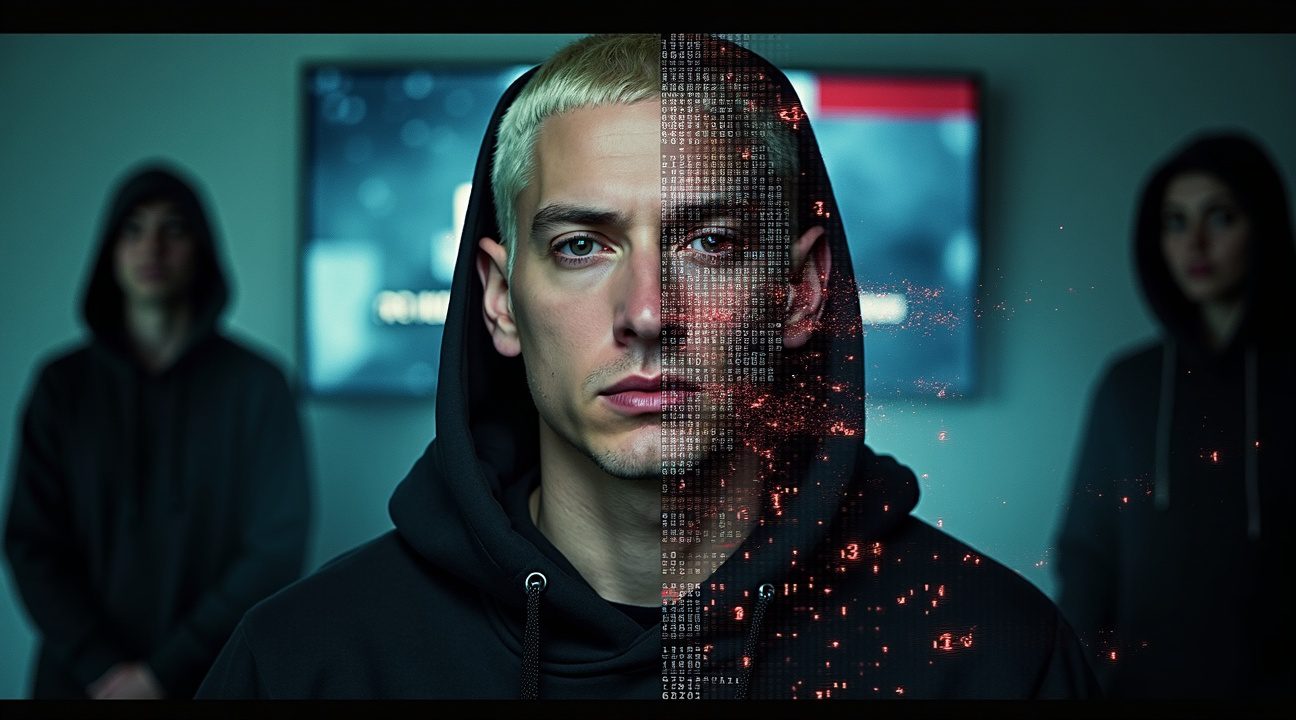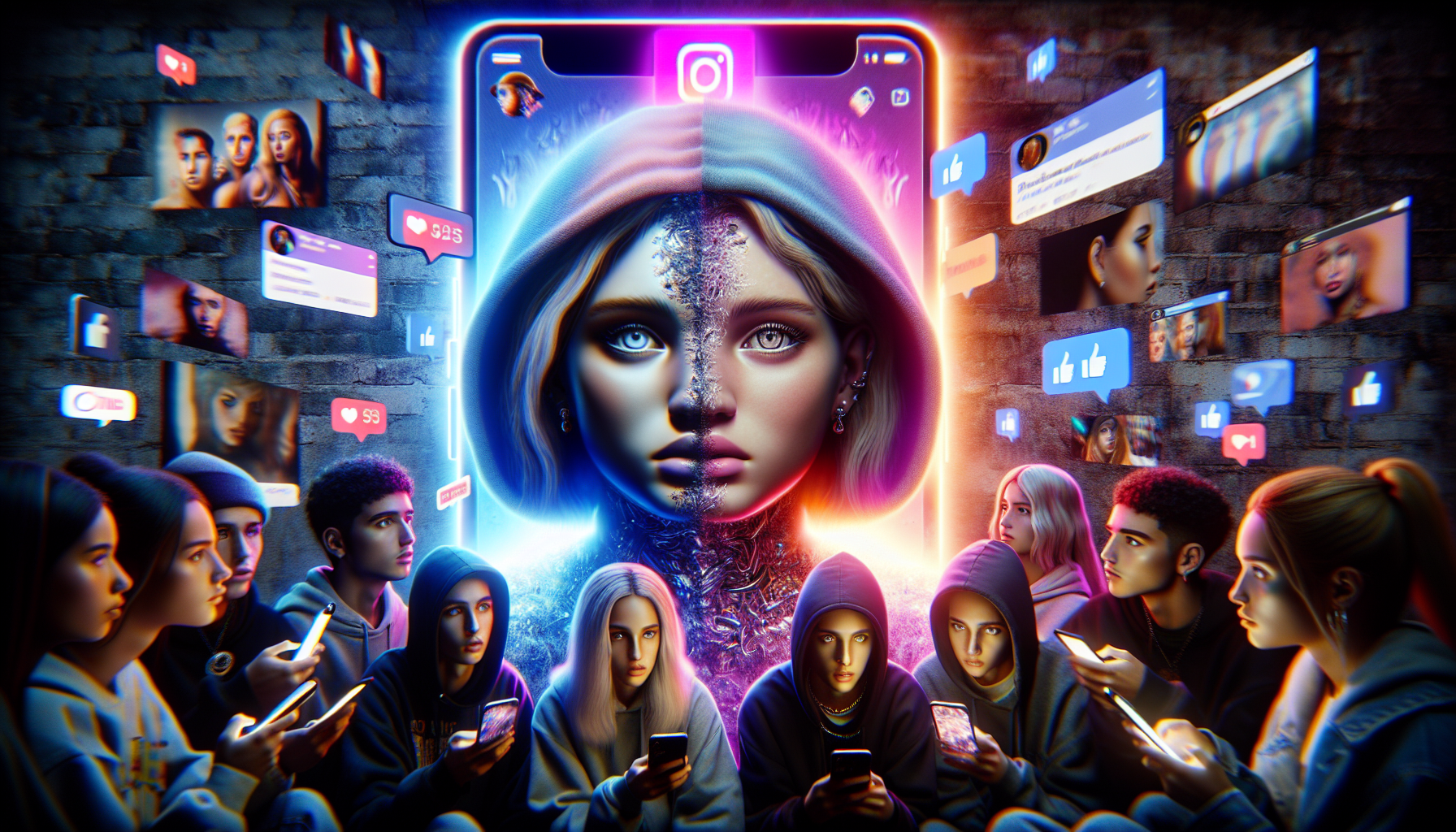A bizarre conspiracy theory suggests that Eminem died in a car accident in 2006 and was secretly replaced by a clone or android, even though there is no credible evidence supporting such a claim.
Key Takeaways
- No official records exist—The theory alleges Eminem died in a 2006 car crash, yet there are no police reports, hospital documentation, or legitimate media coverage to support this.
- Changes in appearance and voice—Believers cite alterations in his facial features, voice, and musical style as “proof,” though experts attribute these to aging, recovery from substance abuse, and the evolution of his artistry.
- Pattern of celebrity replacement theories—Similar theories have targeted other stars like Avril Lavigne and Paul McCartney, relying on supposed physical and stylistic discrepancies.
- Social media influence—The theory regained momentum via TikTok in 2022, where viral videos contrasting “old” and “new” Eminem racked up millions of views and sparked debate among younger users.
- Rational explanations exist—All so-called evidence can be logically explained by natural aging, health issues during his struggle with addiction, and personal growth over his long career.
Music’s Role in Spreading the Theory
Unexpectedly, Tom MacDonald’s song “Cloned Rappers” lent credibility to the conspiracy for some fans. The track explicitly mentions the notion of artists like Eminem being replaced, feeding into the narrative that has found a home in online communities.
The Mysterious 2006 Car Accident That Allegedly Killed Eminem
According to conspiracy theorists, a fatal car crash in 2006 marked the real end of Marshall Mathers’ life, though no credible news outlets or official sources ever reported such an incident. The theory suggests this supposed accident killed the authentic Eminem, leading to his replacement by either a sophisticated clone or android double designed to continue his career seamlessly.
I find it fascinating how this particular conspiracy gained momentum despite the complete absence of evidence supporting a 2006 car accident involving the rapper. No police reports, hospital records, or legitimate news coverage exists to substantiate these claims, yet believers maintain the incident was covered up as part of a larger scheme.
The Tom MacDonald Connection and Modern Spread
The conspiracy received unexpected fuel from Tom MacDonald’s song “Cloned Rappers”, which explicitly references the Illuminati harvesting bone samples to create replicas of famous artists. MacDonald’s track specifically mentions Eminem among the supposedly cloned performers, giving fresh life to theories that had been circulating quietly in online forums since the late 2010s.
Social media platforms dramatically amplified these ideas, with TikTok videos and Reddit discussions dissecting supposed differences in Eminem’s appearance, voice, and lyrical style between his earlier work and more recent releases. Conspiracy theorists point to various factors as “proof” of replacement:
- Changes in facial structure and jawline over the years
- Perceived differences in rap flow and delivery style
- Variations in public behavior and interview demeanor
- Shifts in political and social commentary within his lyrics
These discussions often reference Eminem’s personal struggles as potential motivation for the alleged replacement, suggesting that his battles with addiction and mental health made him a liability requiring substitution.
Despite the theory’s persistence across social platforms, rational explanations exist for all supposed “evidence.” Natural aging, evolving artistic direction, recovery from substance abuse, and changes in personal perspective easily account for any perceived differences in the rapper’s appearance or creative output. The human tendency to seek patterns and hidden meanings often transforms normal life changes into conspiracy fodder, particularly when involving celebrities whose lives are constantly scrutinized by millions of fans worldwide.
https://www.youtube.com/watch?v=mV1z1L1LXA4
The “Evidence” Believers Point To: Voice Changes and Glitching Videos
Conspiracy theorists dedicated to the Eminem clone theory have compiled what they consider substantial evidence supporting their claims. These believers analyze everything from vocal patterns to physical appearance, searching for signs that the real Marshall Mathers was replaced in 2006.
Physical and Vocal Changes That Fuel the Theory
The most frequently cited evidence centers on vocal change patterns that fans claim emerged after 2006. Supporters argue that Eminem’s voice took on different tonal qualities and that his rapping style shifted dramatically from his earlier work. They point to what they perceive as fundamental differences in vocal characteristics that couldn’t be explained by natural aging or vocal evolution.
Photo comparison analysis forms another cornerstone of the conspiracy. Believers scrutinize before-and-after images, claiming to identify changes in facial structure, eye spacing, and jawline proportions. These supposed alterations fuel speculation about surgical replacement, though medical experts consistently point to natural aging, weight fluctuations, and health issues as reasonable explanations for any physical changes.
The infamous “glitch” video from 2013 became viral ammunition for conspiracy supporters. During a live ESPN broadcast, Eminem appeared to freeze momentarily in what looked like a technological malfunction. This footage circulated widely across social media platforms, with believers citing it as visual proof that he’s actually an android or clone experiencing a system error.
https://www.youtube.com/watch?v=YJsImtm4Yzo
Musical style evolution also draws scrutiny from theorists. They suggest a noticeable shift to darker themes and a deeper emphasis on hip hop culture after 2006, interpreting these creative changes as evidence of a different person behind the music. Eminem’s personal struggles and artistic growth over time provide more logical explanations for thematic evolution.
Fashion changes represent another supposed indicator that believers highlight. They document more pronounced shifts in wardrobe choices and style preferences, despite the fact that lifestyle changes and evolving fashion trends offer straightforward explanations for such transformations.
These conspiracy supporters often dismiss conventional explanations, preferring to weave together these observations into a complex narrative about replacement and deception. The theory persists despite the availability of reasonable alternative explanations for each piece of supposed evidence.

How Eminem Joins Avril Lavigne and Paul McCartney in Celebrity Replacement Lore
The Eminem clone conspiracy shares striking similarities with other celebrity replacement theories that have captivated fans for decades. I’ve noticed how these conspiracies follow remarkably similar patterns, particularly when examining the Avril Lavigne and Paul McCartney replacement claims.
The Avril Lavigne theory emerged in the early 2000s, alleging that the Canadian pop-punk star died in 2003 and was replaced by a body double named Melissa Vandella. Proponents of this conspiracy point to subtle changes in her appearance, shifts in her musical style, and supposed hidden clues embedded in her later work. The theory gained significant traction online, with believers analyzing everything from facial features to handwriting samples.
The Beatles Connection and Hidden Messages
Paul McCartney’s replacement conspiracy predates both the Eminem and Avril theories by several decades. According to this theory, McCartney died in a car crash in 1966 and was secretly replaced by a lookalike to prevent mass hysteria among Beatles fans. Believers claim The Beatles left hidden clues in their album covers and songs, including backwards messages and symbolic imagery.
These replacement conspiracies share common elements that make them particularly compelling to certain audiences. Each theory focuses on perceived changes in the celebrity’s physical appearance, vocal qualities, or artistic direction following a specific date. Conspiracy theorists often point to subtle differences in facial structure, body language, or performance style as evidence of replacement.
The hidden clues aspect proves especially fascinating across all three theories. Fans scrutinize lyrics, music videos, and public appearances for supposed coded messages confirming the replacement. Eminem’s personal struggles and artistic evolution become reinterpreted through this lens, with believers claiming certain songs contain admissions or hints about the alleged switch.
What makes these theories particularly persistent is their unfalsifiable nature. Any evidence contradicting the replacement claim gets dismissed as part of the cover-up, while any supporting evidence gets amplified. Changes in artistic direction, which naturally occur as artists mature, become twisted into proof of different people creating the work.
The psychological appeal of these conspiracies extends beyond simple entertainment. They offer believers a sense of special knowledge and community, creating online spaces where people can analyze “evidence” together. The theories also provide explanations for why beloved artists might change or evolve in ways that disappoint longtime fans.

Why the Real Eminem Is Still Very Much Alive
I find it fascinating how conspiracy theories can gain traction online, but the notion that Eminem died in 2006 and was replaced by a clone lacks any foundation in reality. No credible evidence supports this bizarre claim, and there’s absolutely no verifiable record of the rapper dying or being involved in a serious car accident during that year.
Natural Explanations for Perceived Changes
The conspiracy theorists point to changes in Eminem’s voice and appearance as proof of replacement, but these shifts have perfectly logical explanations:
- Aging naturally affects vocal cords and physical appearance over decades
- Eminem’s addiction struggles and subsequent recovery dramatically impacted his health and appearance
- Personal style evolution occurs naturally as artists mature and experiment with their image
- Medical treatments and lifestyle changes during recovery can significantly alter someone’s voice and look
The rapper has been remarkably open about his battles with prescription drug addiction, particularly around 2005–2007. This period of his life involved serious health challenges that would naturally affect his voice, weight, and overall appearance. Recovery from addiction often brings dramatic physical changes as the body heals and adjusts to sobriety.
Conspiracy theorists frequently cite a supposed “glitch” video showing Eminem pausing mid-sentence as evidence of his artificial nature. However, this brief moment represents nothing more than a tired performer taking a pause—something completely normal during interviews or performances. The video shows no unusual behavior that couldn’t be explained by fatigue, distraction, or simply collecting one’s thoughts.
Reputable media outlets and professional fact-checkers have thoroughly investigated and debunked these claims. Major publications consistently find no substantiated basis for the conspiracy theory. The lack of credible sources supporting the death-and-replacement narrative speaks volumes about its legitimacy.
Eminem’s continued career demonstrates remarkable consistency in his artistic vision, personal references, and intimate knowledge of his own life experiences. A clone or replacement couldn’t possibly maintain such detailed continuity across decades of music, interviews, and public appearances.
The real Marshall Mathers continues creating music that reflects his genuine experiences, relationships, and artistic growth. His recent collaborations and personal revelations show an artist who’s very much alive and actively engaged with his craft and personal development.
How TikTok Brought the Clone Theory Back from the Dead
Eminem himself has never taken the clone conspiracy seriously, typically responding with jokes or complete indifference when the topic surfaces. The rapper’s casual dismissal hasn’t dampened believers’ enthusiasm, though. Instead, his personal struggles through music continue to fuel speculation about authenticity among conspiracy theorists.
TikTok breathed new life into this dormant theory in 2022, transforming what was once a fringe internet discussion into a viral phenomenon. Young users discovered the conspiracy through short-form videos, creating content that compared “old Eminem” versus “new Eminem” with dramatic music and split-screen comparisons. These videos accumulated millions of views, introducing the theory to audiences who weren’t even born when the supposed replacement allegedly occurred.
The platform’s algorithm amplified clone theory content by recommending similar videos to users who showed initial interest. Content creators capitalized on this engagement, producing increasingly elaborate theories that dissected everything from facial features to vocal patterns. Some TikTokers presented the conspiracy as fact, while others approached it with obvious skepticism, but both approaches generated significant engagement.
The Viral Mechanics of Celebrity Conspiracies
This resurgence demonstrates how social media platforms function as conspiracy theory incubators. TikTok’s format particularly suits these theories because complex claims can be simplified into digestible, shareable content. The platform’s emphasis on engagement metrics means controversial content often receives more visibility than factual debunking.
Celebrity conspiracies possess inherent viral qualities that make them perfect for social media consumption. They combine familiar faces with mystery, allowing users to feel like amateur detectives uncovering hidden truths. The Eminem clone theory checks all these boxes while requiring no specialized knowledge to understand or discuss.
Internet culture’s tendency to recycle content ensures that old conspiracies never truly die. Platforms like TikTok create cycles where forgotten theories resurface for new audiences, often presented without historical context. Users encountering the Eminem clone theory for the first time might not realize they’re engaging with claims that originated over fifteen years ago.
The theory’s persistence illustrates how factual basis becomes irrelevant in viral conspiracy ecosystems. Evidence against the clone theory exists in abundance:
- Continuous public appearances
- Collaborations with longtime associates
- Documented personal relationships spanning the supposed transition period
However, social media algorithms don’t prioritize accuracy over engagement, allowing unfounded theories to flourish alongside legitimate content.
Modern celebrity culture creates conditions where clone theories can seem plausible to casual observers. Artists often undergo physical changes through aging, weight fluctuations, or lifestyle adjustments. The rap god’s enduring legacy includes natural evolution in his appearance and artistic style, which conspiracy theorists reinterpret as evidence of replacement.
TikTok’s comment sections became battlegrounds where believers and skeptics argued over “proof” of the clone theory. Some users pointed to specific lyrics or interviews as evidence, while others shared side-by-side photos highlighting perceived differences in facial structure. These discussions often ignored logical explanations like:
- Aging
- Different camera angles
- Varying lighting conditions
The phenomenon extends beyond simple entertainment, revealing how social media shapes public discourse around celebrities. Young users might encounter conspiracy theories before learning about an artist’s actual biography or career timeline. This creates situations where fiction potentially influences perception more than documented facts.
Celebrity conspiracies on TikTok also function as engagement tools for creators seeking viral content. The Eminem clone theory provided ready-made material that required minimal research or original thinking. Creators could simply compile existing “evidence” into new formats, generating views without producing genuinely informative content.
The theory’s 2022 revival coincided with increased interest in conspiracy content across social platforms. Users seemed particularly drawn to theories about public figures they recognized, making established celebrities like Eminem prime targets for conspiratorial content. This pattern suggests that clone theories might continue cycling through social media whenever algorithm changes or cultural shifts create favorable conditions for their spread.

Sources:
Screenshot Media, “Internet Culture: Eminem Clone Illuminati”
The Week, “Eminem was replaced by clone in 2006”
Wikipedia, “Eminem”
YouTube, “The Craziest Music Conspiracy Theories” Maddie Balls
YouTube Shorts, “Eminem Was Replaced..”


